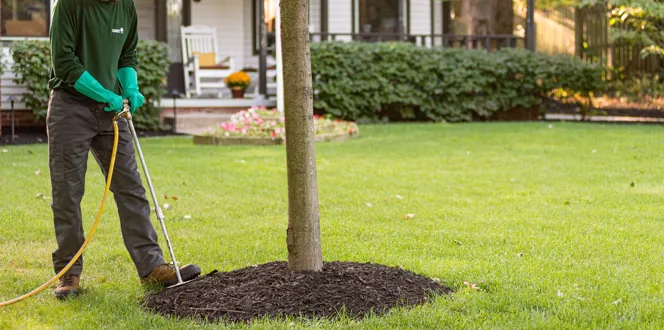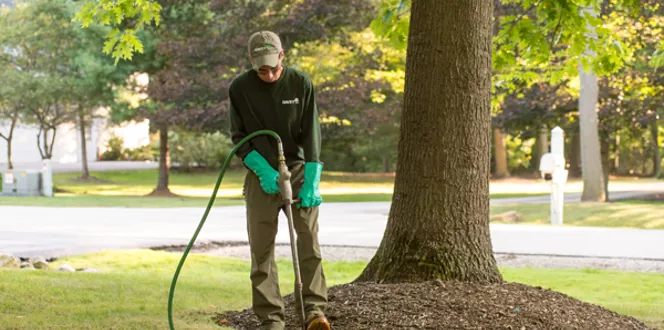Trees grow happy and healthy in forests. This is where they thrive in soils rich in natural humus that is continually replenished by decaying tree leaves and debris. This process returns nutrients to the soil, therefore these trees don’t need fertilization. Organic matter that naturally occurs in forests enables trees to thrive on their own.
Urban and suburban landscapes, on the other hand, are much harsher environments. Leaves and other debris are removed. Development and home building eliminates rich topsoil full of organic matter. Nature’s natural recycling program doesn’t happen in these areas.
As a result, fertilizer is often needed to provide trees with the important nutrients they’re missing.
While trees are strong and natural forests self-sustaining, sometimes we have to give trees in the built environment a little help to thrive and reach their full potential.
Let’s talk about why fertilizing trees in spring is important and discuss some of the basics on fertilization timing to ensure your trees get what they need.
Why You Should Fertilize Your Trees In Spring
Spring is a great time to fertilize your trees. Trees’ demand for nutrients is high as the air and soil warm and they begin to grow again. Nutrient availability at this time will greatly influence how successfully they grow, flower, and fruit throughout the year.
More good news: Lush, thriving trees can boost your curb appeal and home value.
Signs Your Tree Needs Fertilizing
Your tree may already be crying out for nutrients.
Some signs fertilizing trees in spring is needed include:
- Lack of growth. Even if your tree is established and rainfall seems adequate, your tree may not be growing. Every year, you should see some growth in your trees.
- Yellowish leaves in spring and summer vs. a nice green color.
- Leaves that gradually shrink in size year after year. This may be tough to notice in one year, but you should see a difference in more than two years.
- Your tree’s leaves turn to their autumn shade early – in August or September – versus during their normal time later into fall.
- Dead branches or branch tips.
Fertilizing new trees ensures they get established without nutrient deficiencies.
When To Fertilize Trees In Spring
Trees typically need fertilizer when they are growing, but when is the best time to fertilize trees in spring?
For young trees, this is usually best done sometime from March through early May. Growing and mature trees also can benefit from fertilization at this time.
Can You Fertilize Trees In Late Spring?
Using a slow-release fertilizer annually on all tree species is best done in early spring approximately two weeks before trees bloom or begin growing new leaves.
In the southern states, this will happen early – in February – versus in the northern states, which will usually require fertilization in March or April.
Should I Fertilize Trees In Spring Or Fall?
When you’re thinking about which season is best, you might be wondering if there’s a difference between fertilizing trees in spring or fall.
Actually, there are benefits to both seasons.
Fertilizing trees in spring supports new growth, greens up tree leaves, and supplies essential nutrients to avoid any deficits which will restrict growth and flowering throughout the year.
Fertilizing trees in fall helps recover nutrients that were used during the growing season, simulating the timing of nutrient release from autumn leaf fall. If a slow-release fertilizer is used in fall, these nutrients will still be actively released in the spring.
Why You Should Hire A Certified Arborist
Keeping your tree healthy, strong, and gorgeous requires preventive maintenance and routine care.
Hiring a certified arborist can ensure you have knowledgeable, trained eyes on your property that can identify any potential issues and can also properly care for your particular tree species at the proper times of year.
When it comes to fertilizing trees in spring, Davey arborists prefer a slow-release fertilizer. Scientists at the Davey Institute have created various slow-release fertilizer options that address regional differences in soil requirements and macro-and micro-nutrient challenges.





